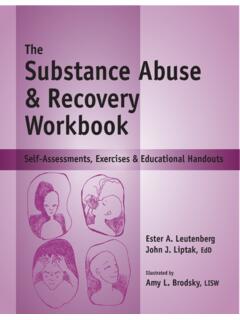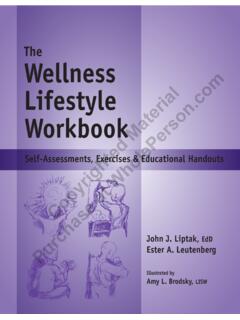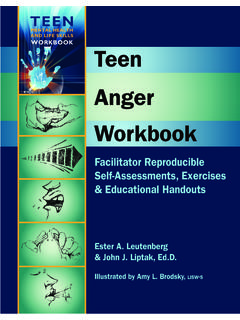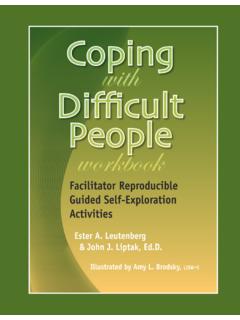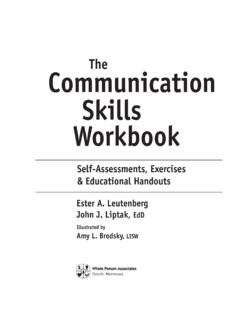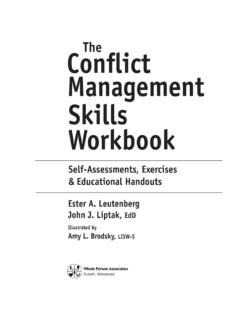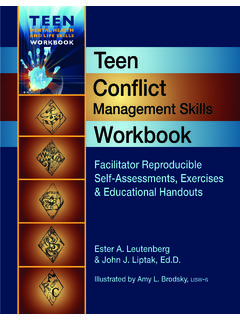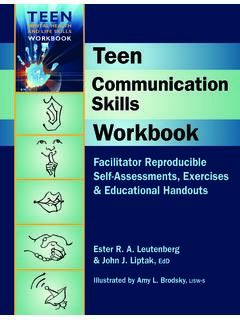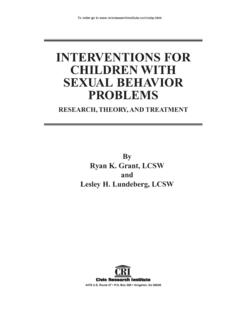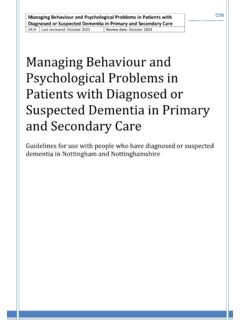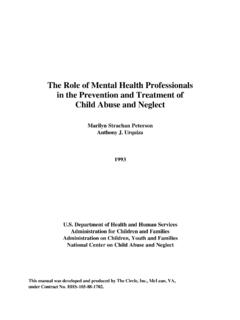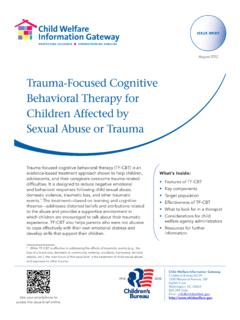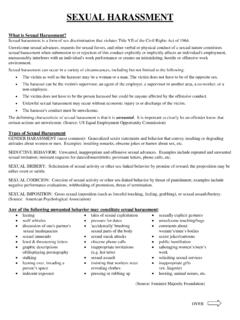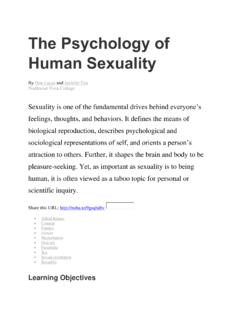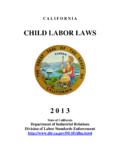Transcription of Managing Disruptive Behavior Workbook for Teens Material …
1 Managing Disruptive Behavior Workbook om rs ial for Teens .c Pe er on le at A Toolbox of Reproducible ho M. Assessments and Activities W ted for Facilitators at gh Ester R. A. Leutenberg se yri and John J. Liptak, EdD. ha p rc Co Erasing the Pu of Mental health issues through Awareness om Managing rs ial .c Pe er on Disruptive Behavior le at Workbook ho M. for Teens W ted at gh A TOOLBOX of REPRODUCIBLE. se yri ASSESSMENTS and ACTIVITIES. ha p for Facilitators rc Co Ester Leutenberg and John J. Liptak, EdD. Pu Duluth, Minnesota om 101 W. 2nd St., Suite 203. Duluth, MN 55802. 800-247-6789. rs ial .c Pe er on Managing Disruptive Behavior Workbook for Teens A Toolbox of Reproducible Assessments and Activities le at for Facilitators.
2 Copyright 2015 by Ester Leutenberg and John Liptak. ho M. All rights reserved. Except for short excerpts for review purposes and materials in the activities and handouts sections, no part of this Workbook may be reproduced or transmitted in any form by any W ted means, electronic or mechanical without permission in writing from the publisher. Activities and handouts are meant to be photocopied. All efforts have been made to ensure accuracy of the information contained in this book as of the date published. at gh The author(s) and the publisher expressly disclaim responsibility for any adverse effects arising from the use or application of the information contained herein.
3 Se yri Printed in the United States of America ha p 10 9 8 7 6 5 4 3 2 1. rc Co Editorial Director: Carlene Sippola Art Director: Joy Morgan Dey Assistant Art Director: Mathew Pawlak Library of Congress Control Number: 2014957802. ISBN: 978-157025-327-0. Pu Introduction Managing Disruptive Behavior Workbook for Teens Disruptive behaviors are characterized by consistent patterns of ongoing, uncooperative, defiant and hostile behaviors. With these behaviors, Teens continue to break the rules. All children break some rules, especially less important rules. More serious Disruptive Behavior is a normal part of maturing. Unfortunately, continued Disruptive Behavior negatively impacts the teen and every person the teen meets.
4 When teenagers are routinely Disruptive , a mental health issue may be involved. As well as teaching Teens the skills to identify and improve their Behavior , one of the purposes of this Workbook is for the facilitator to better understand teen Behavior , not to diagnose it. If the facilitator believes a mental health issue is a om possibility, a school counselor or trained clinician is recommended. rs ial A Guide to Help Teens Manage Disruptive Behavior .c The assessments and activities in this Workbook are designed to provide facilitators with a wide variety of Pe er on tools to use in helping Teens learn to manage their Disruptive behaviors. Many choices for self-exploration are provided for facilitators to determine which tools will help their Teens overcome Disruptive behaviors.
5 Le at The purpose of this Workbook is to provide a user-friendly guide to short-term assessments and activities ho M. designed to help Teens cope with and manage the Disruptive behaviors that are causing problems at school, at home, and in the community. W ted In addition, this Workbook is designed to help provide facilitators and Teens with tools and information needed to be aware of Disruptive behaviors and overcome the stigma attached to them, NOT to diagnose Disruptive Behavior problems. at gh In order to help Teens successfully deal with problem behaviors, it is extremely helpful for facilitators to have a variety of appealing, user-friendly assessments and activities to help Teens open-up and begin to feel as if their problem behaviors can be identified and managed, and that they are not alone.
6 The se yri Managing Disruptive Behavior Workbook for Teens provides assessments and self-guided activities to help Teens reduce the intensity of their problem behaviors, learn coping skills, and begin living more effective and fulfilling lives. ha p rc Co When to Worry? Disruptive Behavior problems surface in classrooms, at home and in the community as Teens argue with adults, deliberately disobey reasonable requests from adults, fight with peers, experience increased moodiness, having trouble controlling their temper, and underachieve in school. Extreme Disruptive behaviors tend to become more intense and longer lasting than typical behaviors of most Teens .
7 The good news is that facilitators can help Teens learn to make small changes that will result in major shifts in their Behavior , as well as to utilize many of the strategies in this Workbook to reduce the Pu intensity and number of Disruptive Behavior problems that Teens will experience. Teens can develop the cognitive, affective, and behavioral skills needed to decrease the amount, depth and duration of their Disruptive Behavior and begin to feel a sense of joy, contentment, and wellbeing. Teens who experience these problem behaviors for an extended period of time are at risk of having a serious Behavior or adjustment problem and need to seek a trained clinician.
8 2015 Whole Person Associates, 101 W. 2nd St., Suite 203, Duluth MN 55802 800-247-6789 iii Managing Disruptive Behavior Workbook for Teens How Does Disruptive Behavior Manifest Itself? In Teens , Disruptive Behavior emerge in a wide variety of ways. It is critical to be aware of and to understand how these symptoms are commonly observed in Teens . While all symptoms may not be present in everything, symptoms that do surface can cause significant distress and/or impairment in daily functioning at home, in school, and within their community. These symptoms cause distress to the Teens themselves and to the people around them. Possible Symptoms: Abuses alcohol and other Harms self om dangerous substances Lacks.
9 Acts out Ability to focus rs ial Angers easily Ability to keep friends .c Annoys others deliberately Impulse control Assaults others verbally, physically Organization habits Pe er on Attempts or contemplates suicide Patience Bullies others Loses . le at Carries or uses weapons Temper Defies authority Things Destroys property Makes careless mistakes ho M. Deliberately annoys others Manipulates others Displays attitudes of Performs poorly in school W ted Anxiety Promotes arguments and fights Boredom Rages Callousness Refuses to obey Emotional emptiness Resents people, events at gh Insolence Resists help Irritability Runs away Spite Self-mutilation, disfigurement se yri Engages in acts of Sinks into moods Arson Skips school Cruelty to people.
10 Animals Steals ha p Engages in unsafe sexual behaviors Threatens suicide Fails to take responsibility Throws tantrums rc Co Fidgets Underachieves Forces sexual relations Unsafe sexual Behavior Forgets Vandalizes Harms others Violates rules Our goal for this Workbook is NOT to diagnose a mental illness, or even for the facilitator to make that diagnosis from this book's content. Please see page ix for further explanation. Pu iv 2015 Whole Person Associates, 101 W. 2nd St., Suite 203, Duluth MN 55802 800-247-6789. Introduction Skills that Teens Will Practice in These Modules Module I Poor Impulse Control Learn self-control Recognize impulse triggers Identify feelings Recognize impulsiveness Develop listening skills Identify irrational thinking Learn ways to focus Define consequences of actions Build mindfulness Discover positive assertive behaviors Identify negative thoughts Manage anger om Module II Defiant Attitude Recognize anger situations Define conflicts: Where, when, why and with whom Identify one's aggressiveness Discover causes of conflict rs ial Understand reactions to authority figures Identify positive aspects of one's life.
